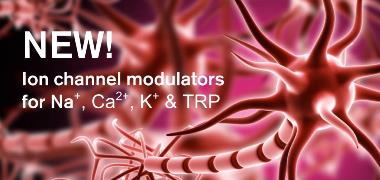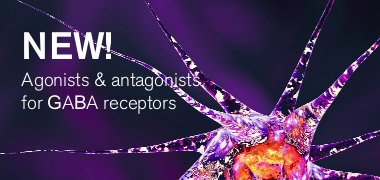Pain signaling pathways

The sensation of pain can be separated into neuropathic,inflammatory and nociceptive pain which are stimulated by heat, acid, mechanical pressure and cold. This pathway poster summarises the complex interplay of peripheral sensitization, central sensitization and inhibition. Download pdf
Signaling Pathways in Peripheral Pain Sensitization
The activation of receptors and channels at afferent nociceptor Aδ and C fibre terminals leads to the generation of an action potential that travels up the spinal cord to the brain for conscious pain perception. ASIC, TRPA1 and TRPV1 channels open in response to a decrease in pH and H+ binding, leading to Ca2+ and Na+ influx.
Inflammatory mediators produced by damaged cells and immune cells activate prostaglandin EP, bradykinin B1/2 and cytokine receptors. Serotonin and ATP activate 5-HT2A/3 receptor and P2X3 receptors respectively. Activation of these receptors activates ERK, p38, PKA, PLC and PKC causing release of intracellular Ca2+. These enzymes also increase Ca2+ and Na+ influx and inhibit K+ influx.
Inflammatory mediators can cause peripheral sensitization where innocuous stimuli is experienced as painful. There is increased gene translation and trafficking of ion channels and receptors, with a lowered activation threshold of the TRPV1 channel due to PKC phosphorylation.
There is also central sensitization of pain mediated by glutamate receptors and disinhibition via loss of GABA and glycine inhibition.
Signaling Pathways in Pain Inhibition
Inhibition of peripheral pain is mediated by several receptors such as GABA and glycine receptors which are expressed on afferent neurons pre-synaptically or on dorsal horn neurons post-synaptically. Activation of these receptors decreases the response to noxious stimuli through an influx of Cl-.
Activation of α2-adrenoceptors by noradrenaline decreases cAMP and inhibits PKA, increasing glycine receptor activity.
Dorsal horn neurons can express mAChRs which are agonised by acetylcholine, inhibiting nociception.
Opioid receptors are also expressed, responding to endogenous enkephalin and β-endorphin produced by monocytes. Opioid, CB1 and mGlu2/3 receptors inhibit Ca2+ and Na+ channels and activate K+ channels.
References
Basbaum AI, Bautista DM, Scherrer G, Julius D (2009) Cellular and molecular mechanisms of pain. Cell. 139(2):267-84. Pan HL, Wu ZZ, Zhou HY, Chen SR, Zhang HM, Li DP (2008) Modulation of pain transmission by G-protein-coupled receptors. Pharmacol Ther. 117(1):141-61. Petho G, Reeh PW (2012) Sensory and signaling mechanisms of bradykinin, eicosanoids, platelet-activating factor, and nitric oxide in peripheral nociceptors. Physiol Rev. 92(4):1699-775. Schaible HG (2007) Peripheral and central mechanisms of pain generation. Handb Exp Pharmacol. 177:3-28. Schaible HG, Ebersberger A, Natura G (2011) Update on peripheral mechanisms of pain: beyond prostaglandins and cytokines. Arthritis Res Ther. 13(2):210. Scholz J, Woolf CJ. (2002) Can we conquer pain? Nat Neurosci. 5 Suppl:1062-7. Woolf CJ, Ma Q (2007) Nociceptors--noxious stimulus detectors. Neuron. 5:353-64.
Pain research tools
Browse our range of tools for pain research below:
| G protein coupled receptors | Ionotropic receptors Ion channels | Enzymes
Cell signaling
|
Most popular pain research ranges
Featured pain research products
Our new Transient Receptor Potential (TRP) ion channel range features affordable standard activators and blockers for TRP channels receptors. Examples include the potent TRPV1 antagonist Capsazepine
Standard tools such as the GABAA- antagonists SR95531 (gabazine) and Bicuculline methochloride are available.







